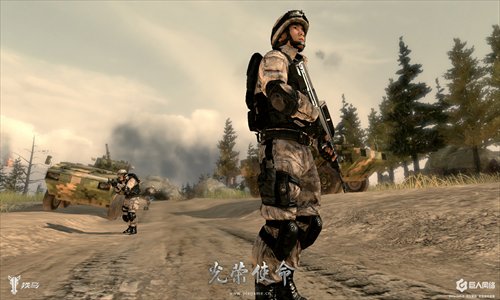Lock and load

First-person shooter video games have a strong fan base in China, with many military enthusiasts taking up virtual arms in games such as those in the franchises of Call of Duty, Total War and Company of Heroes. Then there are those who favor strategy and spy-like stealth by embracing missions in games from the Metal Gear Solid and Commandos series.
All these games enjoy a stellar reputation among both Chinese and overseas players and many are classics in their own right. Yet they also share another common aspect: none have the "Made in China" tag. But Chinese video game makers hope to change this through the production of around 4 million copies of Glorious Mission, which hit the domestic market on September 18.
Jointly produced by the People's Liberation Army (PLA) and domestic video game maker Giant Interactive Group, the online first-person shooter isn't merely a commercial product. It was originally designed to simulate battle scenarios for PLA soldiers and, no doubt, entertain them during their spare time.
The game was deployed among PLA troops in November last year. It was met with such popularity that a version for civilian gamers was also launched. Glorious Mission is modeled on game engine Unreal 3, a system designed for the creation of video games.
This lead to detailed graphics depicting PLA weaponry and 3D maneuvers based on soldier drills. Even the dubbing of characters' voices in the game comes from real PLA soldiers.
Chinese gamers have welcomed Glorious Mission warmly, claiming its arrival is long overdue. Shan Dan, a 21-year-old college student and avid gamer, told Metro Beijing that he would buy an authorized copy of the game to support the domestic industry.
"Games like those from the Call of Duty series have sold millions of copies worldwide, yet you can hardly find Chinese soldiers in military games produced by the West. If you do, they are inevitably depicted as hostile forces," said Shan. "China is short of video games representing our own soliders." The commercial version does not specifically identify the nationality of enemy forces.
Domestically engineered military video games are rare in China, but there are some notable predecessors to Glorious Mission. Resistance Against Japanese Aggression: Landmine Warfare produced by Xishanju Studio in 1998 was the first Chinese-innovated military strategy game. As its name suggests, the game requires players to defeat invading Japanese troops by using landmines.
While becoming a cult classic, the game's crude 2D graphics appear shabby when viewed today. The game's Japanese troops have more than 40 different units with overwhelming firepower, requiring the player to use landmines sparingly to repel their advance. The game also includes cameos by historical figures, such as military leader Lin Biao (1907-71).
Another one of Xishanju Studio's games, Decisive Battle in North Korea, is even more popular among Chinese gamers. The 1999 game is based on the Korean War (1950-53), specifically China's involvement fighting alongside North Korean troops against international allied forces.
One of the game's strongest attributes is its attention to historical details, with most skirmishes based on real battles.
There's even the chance to change the course of history by helping North Korean leader Kim Il-sung (1912-94) defeat forces under US Commander Douglas MacArthur (1880-1964) and win the war.
The 2003 release of Resistance Against Japanese Aggression: Bloody War at the Shanghai Bund resulted in players being more confined to follow the storyline with fewer possible outcomes, while its 2004 follow-up, Bloody War at Myanmar, enlists players to follow the familiar script of defeating Japanese troops.
The frequent appearance of Japanese soldiers as villains might suggest that Chinese military video games not only lack of productivity, but also originality.
Zhu Jiayin, a video game designer who has more than 10 years' experience in the industry, told Metro Beijing that censorship is a risky battleground for video game makers.
"The War of Resistance Against Japanese Aggression (1937-45) is a relatively safe topic to handle as we all know the result of that war, but other topics are different. I know a company once planned a game based on the Long March, but it was turned down by supervising officials," said Zhu, referring to the Red Army's historic retreat between 1934 and 1935. "Their reasoning was simple: all games must include failed scenarios, but how can the Long March be depicted as a failure?"
But censorship is not the only obstacle for video game makers, who must cater to the popularity of role playing games.
"Few people play military video games now. The developed role playing game market has made companies lose their courage to explore other genres," he said.